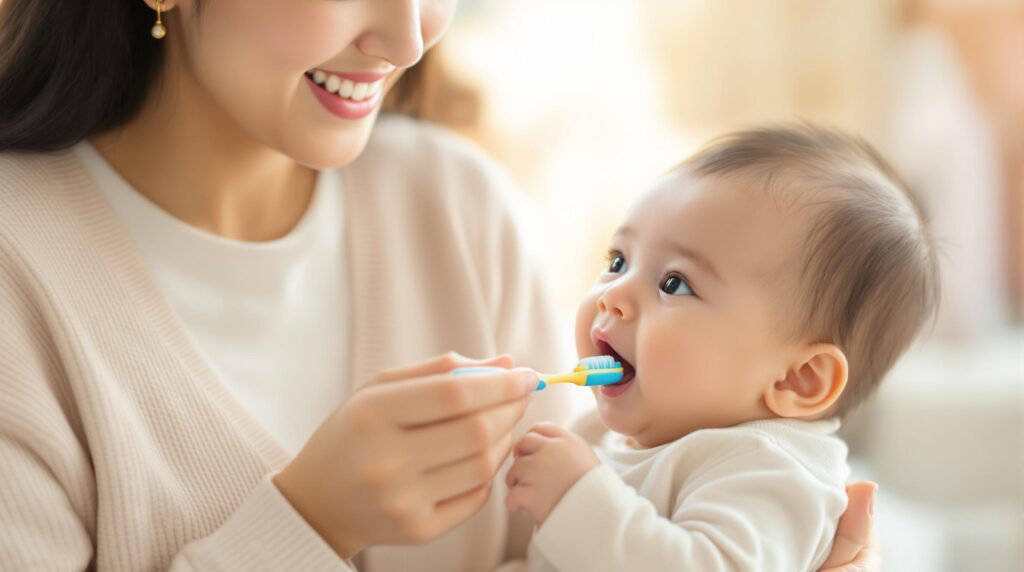Table of Contents
ToggleHere’s the updated article with the new image source:
Introducing a toothbrush to your teething baby is a crucial step in establishing good oral hygiene habits that will last a lifetime. As a parent, you play a vital role in guiding your little one through this important milestone. Let’s explore how you can make this process smooth, enjoyable, and effective for both you and your baby.
The Importance of Early Oral Hygiene for Babies
Starting oral care early is essential for your baby’s overall health and well-being. By introducing a toothbrush when your baby’s first tooth appears (typically around 6 months), you’re setting the foundation for a lifetime of healthy smiles. The American Academy of Pediatric Dentistry (AAPD) emphasizes the significance of this early start, as it helps prevent dental problems and establishes routines that will benefit your child for years to come.
Early oral hygiene isn’t just about clean teeth; it’s about creating positive associations with dental care. By gently introducing a toothbrush during the teething phase, you’re helping your baby become comfortable with the sensation of brushing. This familiarity can make future dental visits and daily oral care routines much easier.
Moreover, proper oral hygiene from an early age can prevent a host of dental issues. Baby teeth, although temporary, play a crucial role in your child’s development. They help with proper speech formation, chewing, and act as placeholders for permanent teeth. Neglecting these primary teeth can lead to problems with permanent teeth alignment and even impact your child’s overall health.

Selecting the Right Toothbrush for Your Baby
Choosing the appropriate toothbrush for your baby is a critical step in introducing oral care. The right toothbrush can make the experience comfortable and enjoyable for your little one, encouraging a positive attitude towards dental hygiene.
Key Features to Look For
When selecting a toothbrush for your baby, focus on these essential features:
- Soft Bristles: Opt for extra-soft bristles to protect your baby’s delicate gums and emerging teeth. Soft bristles effectively clean without causing discomfort or irritation.
- Small Head: A compact brush head allows easy maneuverability in your baby’s tiny mouth, reaching all areas comfortably.
- Large Handle: Choose a toothbrush with a chunky, easy-to-grip handle. This design helps you maintain control while brushing and will be useful later when your baby starts to hold the brush.
- Non-Toxic Materials: Ensure the toothbrush is made from safe, BPA-free materials, as babies often chew on their brushes.
Remember, the goal is to find a toothbrush that’s comfortable for your baby and easy for you to use. Some parents find that finger toothbrushes, which slip over your finger, work well for very young babies. As your child grows, you can transition to a traditional infant toothbrush.
Gentle Introduction: Getting Your Baby Used to the Toothbrush
Introducing a toothbrush to your teething baby requires patience and a gentle approach. The key is to make the experience positive and non-threatening. Here’s how you can keep your baby happy during teething while introducing oral care:
Start with Gum Massage
Before your baby’s first tooth emerges, start by gently massaging their gums with a clean, damp washcloth or a soft silicone finger toothbrush. This helps your baby get used to having something in their mouth and can provide relief from teething discomfort.
Introduce the Toothbrush Gradually
Once the first tooth appears, introduce the toothbrush slowly:
- Let your baby hold and examine the toothbrush, treating it like a new toy.
- Demonstrate brushing on yourself or a favorite stuffed animal.
- Gently touch the toothbrush to your baby’s lips and gums, allowing them to get used to the texture.
- Start with brief sessions, just a few seconds long, and gradually increase the duration as your baby becomes more comfortable.
Use Water or Fluoride-Free Toothpaste
For babies under 3 years old, use only water or a rice grain-sized amount of fluoride-free toothpaste. This prevents any issues if your baby swallows the toothpaste. As your child grows and learns to spit, you can transition to fluoride toothpaste under pediatric dentist guidance.
Making Toothbrushing a Family Affair
Incorporating toothbrushing into your family routine can significantly impact your baby’s attitude towards oral care. Children are natural imitators, and they often adopt habits they observe in their parents and siblings.
The Power of Parental Role Modeling
When your baby sees you brushing your teeth regularly and enjoying the process, they’re more likely to view it as a positive activity. Here’s how you can make toothbrushing a family event:
- Brush your teeth alongside your baby, narrating what you’re doing.
- Invite older siblings to join in, creating a fun family routine.
- Use positive reinforcement, praising your baby’s efforts and participation.
Studies have shown that children whose parents model good oral hygiene habits are more likely to maintain these habits into adulthood. By making toothbrushing a shared activity, you’re not just cleaning teeth; you’re instilling lifelong healthy habits.
Keeping Your Baby’s Toothbrush Clean and Safe
Maintaining a clean toothbrush is crucial for your baby’s health. The Centers for Disease Control and Prevention (CDC) provides guidelines for toothbrush hygiene that are especially important for infants:
Cleaning and Storage
- Rinse the toothbrush thoroughly with tap water after each use.
- Allow the toothbrush to air-dry in an upright position.
- Don’t cover toothbrushes or store them in closed containers, which can promote bacterial growth.
- Keep toothbrushes separated to prevent cross-contamination.
Regular Replacement
Replace your baby’s toothbrush every 3-4 months or sooner if:
- The bristles become frayed or worn
- Your baby has been sick
- The toothbrush has been dropped on the floor or in unsanitary conditions
Regular replacement ensures that the toothbrush remains effective and free from harmful bacteria.
Fun and Interactive Tooth Brushing Techniques
Making toothbrushing enjoyable can transform it from a chore into a cherished part of your baby’s routine. Here are some creative ways to make brushing fun:
Incorporate Songs and Games
Create a special toothbrushing song or use an existing one to time the brushing session. Many parents find that singing helps distract and entertain their baby during brushing.
Use Props and Storytelling
Introduce a puppet or stuffed animal that “helps” with brushing. Create stories about fighting off “sugar bugs” to make the process more engaging.
Let Your Baby Participate
As your baby grows, allow them to hold the toothbrush and attempt brushing themselves. This fosters independence and makes them feel involved in their oral care.
Remember, the goal is to create positive associations with toothbrushing. By making it fun and interactive, you’re setting the stage for a lifetime of good oral hygiene habits.
Adapting Oral Care to Your Baby’s Development
As your baby grows, their oral care needs will evolve. Understanding the developmental milestones related to teething and oral skills can help you adapt your approach effectively.
Teething Stages and Oral Care
Knowing when to expect the first tooth and subsequent teeth can help you prepare for changes in your oral care routine. Here’s a general timeline:
- 6-10 months: First teeth (usually bottom front) appear
- 9-16 months: Top front teeth emerge
- 13-19 months: First molars come in
- 16-23 months: Canine teeth appear
- 23-33 months: Second molars emerge
As new teeth come in, adjust your brushing technique to ensure you’re cleaning all surfaces effectively.
Motor Skill Development
Your baby’s ability to participate in toothbrushing will increase with age:
- 6-12 months: Baby may grab at the toothbrush
- 12-18 months: Baby might try to imitate brushing motions
- 18-24 months: Baby may attempt to brush independently (with supervision)
- 2-3 years: Child can start learning to spit out toothpaste
Encourage your child’s increasing independence while still providing necessary assistance and supervision.
Adapting to Sensory Sensitivities
Some babies may be more sensitive to textures or sensations in their mouth. If your baby seems resistant to brushing, try:
- Different toothbrush textures (e.g., silicone vs. bristles)
- Varying water temperatures
- Allowing your baby to chew on the toothbrush to get comfortable
By being flexible and attuned to your baby’s needs, you can smoothly introduce a toothbrush and establish a positive oral care routine.
Conclusion
Introducing a toothbrush to your teething baby is a significant milestone in their development and your journey as a parent. By starting early, choosing the right tools, and making the process enjoyable, you’re setting the foundation for a lifetime of good oral health habits. Remember, every baby is different, so be patient and flexible in your approach. Celebrate small victories and know that with consistency and care, you’re giving your child the gift of a healthy smile.
As you navigate through different teething stages, keep in mind that your pediatrician and pediatric dentist are valuable resources. Don’t hesitate to seek their advice if you have concerns or questions about your baby’s oral health. With the right approach and a bit of patience, you’ll find that introducing a toothbrush can be a positive experience for both you and your baby.
Sources:
American Academy of Pediatric Dentistry (AAPD) – Oral Health Policies
Centers for Disease Control and Prevention (CDC) – Oral Health
National Institute of Dental and Craniofacial Research (NIDCR) – Oral Health in America: A Report of the Surgeon General
American Dental Association (ADA) – Caring for Your Baby’s Teeth
U.S. Department of Health and Human Services – HealthyChildren.org
National Library of Medicine – PubMed: Developmental Milestones
American Academy of Pediatrics (AAP) – Policy Statement: Oral Health Risk Assessment Timing and Establishment of the Dental Home
Centers for Disease Control and Prevention (CDC) – Brushing Your Teeth
National Institute of Child Health and Human Development (NICHD) – How to Care for Your Baby’s Teeth
U.S. Department of Health and Human Services – Health.gov: Oral Health












